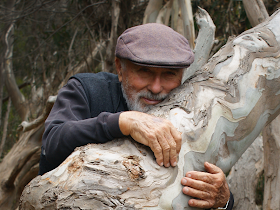As documentaries go, you'll be hard put to find a more upbeat, life-affirming, out-and-out fascinating example than BOTSO, the nickname of the film's amazing protagonist: a musician/ sculptor/teacher born in Georgia (the far-off Eastern European state, rather than ours here in the south), who's now 92 years old and still going strong. "Botso," he explains early on, means "young steer" in the Georgian language. "In fights," he explains further, "I used my head first." There's not a lot of fighting in this movie, however. It would appear that Botso has clearly outgrown that.
What the film offer in spades is the story of a life so full of incident and surprise, horror and hope, travel (sometimes enforced) and fulfillment that there is enough here to take in several lives. Our own small and rather paltry examples of living may pale by comparison, yet seeing this documentary should certainly turn us toward living to the fullest. As directed by Tom Walters, shown at right, and written by Hilary Grant, this life of Wachtang "Botso" Korisheli -- one hell of a fine fellow with the remarkable ability to make the best of just about anything -- unfolds before us as the kind of adventure seldom seen nor heard in our experience.
Who else, as a child, would have received a warm pat on his shoulder from Joseph Stalin, who had come to see Botso's father (pictured in the portrait above right), a famous Georgian actor, in a play. "You must be very proud of him," Stalin tells the boy, and then, within two years has the father executed, while the home of the boy and his mother is taken over by the state and stocked with political prisoners on their way to detention camps.
Once the man arrives in America, he crosses the paths of everyone from musical royalty to film star Janet Gaynor and ends up finding his gift for sculpture, too, then teaching it and music in Los Angeles and finally at Santa Barbara's Morro Bay. His students now number in the hundreds, some of them famous, most all of them indebted and grateful.
Walters and Grant weave Botso's tale back and forth from present to past, using some splendid archival footage and only a very few "reconstructions." They understand what a guy they have in tow and so let him tell his tale in his own way and time. We follow along as Botso returns to Georgia for a kind of reunion, where we see what a gorgeous country is his homeland (below).
Made, it appears, over at least a five-year period, the movie allows us to see some of the man's students as both younger and then older children. We meet his much younger wife and his own slew of adopted children (having contracted mumps as a child, he was made sterile), and see the home he's created entirely by hand (nothing bought from even a hardware store, we're assured).
Some of the loveliest moments come from simply hearing Botso's philosophy: "Nature has a harmony that we should learn. You fight nature, you fight yourself." A remarkable human being and talent, Botso has now made a remarkable documentary that it's a privilege to see and hear.
The movie, running a fast and mostly effortless 82 minutes, opens this Friday, October 10, in New York City at the Quad Cinema, and on October 24 in Los Angeles at Laemmle's Music Hall 3.
Personal appearance: Director Tom Walters will host Q&A's
following the 7:30pm show on Friday 10/10 and following the 5:20pm
and 7:30pm screenings on Saturday 10/11 and Sunday 10/12.
He will be joined by writer Hilary Grant and editor Randi Barros
for the 7:30 shows.









Wonderful article about a wonderful man and wonderful film. However, Botso currently lives in Morro Bay, a beautiful, small California coastal town in San Luis Obispo County. Santa Barbara is about 100 miles to the south.
ReplyDeleteThanks so much for posting, Janice, and for the geography lesson, too. I'm from California (L.A. area) but my understanding of points north leaves something to be desired. (I know San Luis Obispo via the Madonna Inn, which I understand is still there and open for business.)
ReplyDelete